The American Revolutionary War (1775–1783), also known as the American War of Independence, was a war fought primarily between Great Britain and revolutionaries within the thirteen North American colonies. The war, which eventually widened far beyond British North America, resulted in the overthrow of British rule in the thirteen colonies and the establishment of the United States of America.

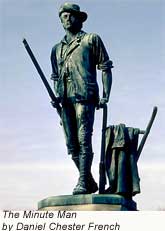 When the war began, the thirteen American colonies did not have a professional army (also known as a "regular" or "standing" army). Each colony instead provided for its own defenses through the use of local militia. Militiamen served for only a few weeks or months at a time, were generally reluctant to go very far from home, and would often come and go as they saw fit. Militia typically lacked the training and discipline of regular troops, but could be effective when led by talented officers. When the war began, the thirteen American colonies did not have a professional army (also known as a "regular" or "standing" army). Each colony instead provided for its own defenses through the use of local militia. Militiamen served for only a few weeks or months at a time, were generally reluctant to go very far from home, and would often come and go as they saw fit. Militia typically lacked the training and discipline of regular troops, but could be effective when led by talented officers.
Seeking to coordinate colonial military efforts, the Continental Congress established (on paper) a regular army—the Continental Army—in June of 1775, and appointed George Washington as commander-in-chief. The development of the Continental Army was always a work in progress, and Washington reluctantly augmented the regular troops with short-term colonial militia throughout the war. Although as many as 250,000 men may have served the colonies as regulars or militiamen in the eight years of the war, there were never more than 90,000 total men under arms for the colonies in any given year. The greatest number of men that Washington personally 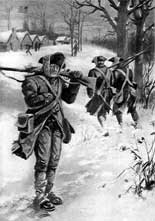 commanded in the field at any one time was fewer than 17,000. commanded in the field at any one time was fewer than 17,000.
In 1775, Great Britain had a worldwide standing army of somewhere around 50,000 men. An additional 30,000 German mercenaries (popularly known as Hessians) were hired by the British over the course of the war. Fewer than 20,000 of these ever set foot in America. The war was far from Britain's greatest concern at the time. Loyalists—American colonists who sided with the British—fielded perhaps 50,000 men during the war years. However, according to reliable modern estimates, total British strength in the colonies did not exceed 20,000 men at any one time.

During the first three years of the American Revolutionary War, the primary military encounters were in the North. One notable exception was in June of 1776, when General Henry Clinton sailed south to attack Charleston, South Carolina. This ended in humiliating defeat for the British, and the revolutionaries remained in control of the southern colonies for the next three years. Starting in 1778, the British once again turned their attention to the colonies of Georgia, South Carolina, North Carolina, and Virginia, where they hoped to regain control with the assistance of southern Loyalists.
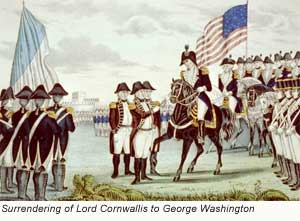 The northern, southern, and naval theaters of the war converged at Yorktown in 1781. On September 5, 1781, French naval forces defeated the British Royal Navy at the Battle of the Chesapeake, cutting off British General Cornwallis's supplies and transport. Washington hurriedly moved his troops from New York, and a combined Franco-American force of 17,000 troops commenced the Battle of Yorktown on October 6, 1781. Cornwallis's position quickly became untenable, and on October 19 his army surrendered. The war was all but over. British Prime Minister Lord North resigned upon hearing the news from Yorktown. In April 1782, the British House of Commons voted to end the war with the American colonies. On November 30, 1782 preliminary peace articles were signed in Paris; the formal end of the war did not occur until the Treaty of Paris was signed on September 3, 1783 and the United States Congress ratified the treaty on January 14, 1784. The last British troops left New York City on November 25, 1783. The northern, southern, and naval theaters of the war converged at Yorktown in 1781. On September 5, 1781, French naval forces defeated the British Royal Navy at the Battle of the Chesapeake, cutting off British General Cornwallis's supplies and transport. Washington hurriedly moved his troops from New York, and a combined Franco-American force of 17,000 troops commenced the Battle of Yorktown on October 6, 1781. Cornwallis's position quickly became untenable, and on October 19 his army surrendered. The war was all but over. British Prime Minister Lord North resigned upon hearing the news from Yorktown. In April 1782, the British House of Commons voted to end the war with the American colonies. On November 30, 1782 preliminary peace articles were signed in Paris; the formal end of the war did not occur until the Treaty of Paris was signed on September 3, 1783 and the United States Congress ratified the treaty on January 14, 1784. The last British troops left New York City on November 25, 1783.
The reasons for Great Britain's misfortunes and defeat may be summarized as follows: Misconception by the home government of the temper and reserve strength of her colonists; disbelief at the outset in the probability of a protracted struggle covering the immense territory in America; consequent failure of the British to use their more efficient military strength effectively; the safe and Fabian generalship of Washington; and finally, the French alliance and European combinations by which at the close of the conflict Great Britain was without a friend or ally on the continent.

Decisive victory eluded the United States on the western frontier. However, Great Britain negotiated the Paris peace treaty without consulting her Indian allies, and ceded Indian territory to the United States. Full of resentment, Native Americans reluctantly confirmed these land cessions with the United States in a series of treaties, but the result was essentially an armed truce—the fighting would be renewed in conflicts along the frontier, the largest being the Northwest Indian War.
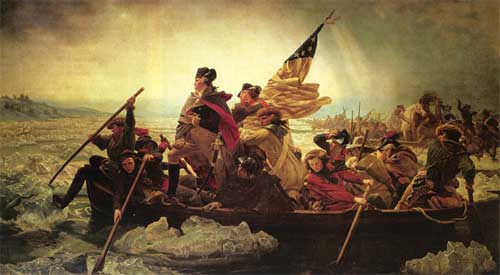
The total loss of life resulting from the American Revolutionary War is unknown. As was typical in the wars of the era, disease claimed more lives than battle. Often overlooked is the fact that the war took place in the context of a massive smallpox epidemic in North America that probably killed more than 130,000 people. Historian Joseph J. Ellis suggests that Washington's decision to have his troops inoculated may have been the commander-in-chief's most important strategic decision.
Casualty figures for the American revolutionaries have varied over the years; a recent scholarly estimate lists 6,824 killed and 8,445 wounded in action. The number of American Patriot troop deaths from disease and other non-combat causes is estimated at about 18,500.
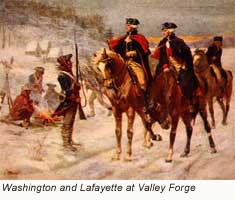 Approximately 1,200 German mercenaries were killed in action and 6,354 died from illness or accident. About 16,000 of the remaining German troops returned home, but roughly 5,500 remained in the United States after the war for various reasons, many becoming American citizens. No reliable statistics exist for the number of casualties among other groups, including American Loyalists, British regulars, American Indians, French and Spanish troops, and civilians. Approximately 1,200 German mercenaries were killed in action and 6,354 died from illness or accident. About 16,000 of the remaining German troops returned home, but roughly 5,500 remained in the United States after the war for various reasons, many becoming American citizens. No reliable statistics exist for the number of casualties among other groups, including American Loyalists, British regulars, American Indians, French and Spanish troops, and civilians.
According to data from the Daughters of the American Revolution, the last surviving U.S. veteran of the conflict, George Fruits, died in 1876 at the age of 114. However, Fruits was never on a pension roll. The last surviving veteran may have been Daniel F. Bakeman (died 1869), who was placed on the pension rolls by an act of U.S. Congress and is listed as the last survivor of the conflict by the United States Department of Veterans' Affairs.
|